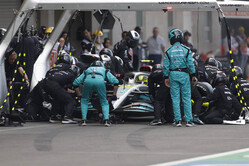


07/11/2022
NEWS STORY
 Following negative claims by the drivers, teams have called for a rethink on the plan to ban tyre blankets in 2024.
Following negative claims by the drivers, teams have called for a rethink on the plan to ban tyre blankets in 2024.
The FP2 sessions at the Circuit of the Americas and Mexico City given over to tyre testing for Pirelli weren't only about giving feedback on the proposed 2023 compounds.
With the FIA set to ban tyre warmers from 2024, over the course of the preceding seasons the sport is gradually weening the teams off the practice, with the maximum temperature reduced to 70 degrees this year and then 50 degrees next season.
The FP2 sessions in Austin saw the tyres heated to just 50 degrees in preparation for next season, but following complaints from the drivers this was raised back to 70 degrees in Mexico, yet still it was clear that drivers were struggling.
"We're going to have a lot of crashes," predicted Max Verstappen following the Austin test. "Also, your tyre degradation is going to be completely different because your tyres are very cold, you're sliding around a lot in the first few laps, your tyre pressures are going to go through the roof.
"Your tyres are going to deg a lot more and, at the moment, I don't really enjoy but I mean a lot of drivers say the same," he added. "We have to of course find a solution to that.
"Austin is still a track where you can easily switch on the tyres because of the high-speed cornering, but if you go to a track like a street circuit, Monaco, can you imagine on half-half conditions? I think is going to take like half the race before you have temperature in your tyres.
"You have a lot less power," he responded when asked how other categories manage without the blankets, "these cars are very heavy as well. I've tried it and it's just really almost impossible to drive.
"In my private time I drive a GT3 car with no tyre blankets, but these cars are a lot more forgiving and it's a lot easier to manage than these kind of cars, because if you go on the power a little bit too much, with the power you have from the engine, I mean it can be a big, big issue."
"This was like the best possible conditions to have these tyres; super warm, hot track temp, high-speed first sector to get the temp in, and they were not nice," said Lando Norris. "It's so easy to front lock, so easy to rear lock, completely unpredictable.
"Imagine going to a much colder race track, or if it's a little bit damp or something... everyone's going to shunt the car at some point."
"It's quite hard to compare because we did a harder tyre in Austin at a lower blanket temperature," said Mercedes Andrea Shovlin following the Mexico test. "What we have now is, you know, what we had this weekend is very similar to what we've run before.
"I think the challenge of taking a car that's this fast, this powerful, that has this much downforce and making a blanket-less tyre is incredibly difficult," he admitted. "I think it's very easy to look at the Formula 2 series and say, 'well, they do it', but the energies involved are enormously higher, we're doing around 20 seconds quicker at some circuits.
"That challenge for Pirelli is very, very difficult. It requires a lot of steps of technical development. And the sport has to be very careful that the legislation on blankets does not get ahead of the rate at which we can develop the tyres.
"Pirelli's problem is not a static one. These cars have got more downforce in a straight line than the cars we used to have. The high-speed loads are very, very high and the teams are constantly working to add performance. And for Pirelli to just keep up with that constant development is difficult.
"So you would say 'yes, of course, you can make a blanket-less tyre', Pirelli probably could give us one straightaway. But that tyre would not lead to good racing, it would not allow the drivers to push as hard, you would end up with very high tyre pressures and a significant loss of grip.
"It's a case of balancing the needs of the sport, along with environmental concerns that are all being addressed. But the big concern is making sure that we don't end up with a worse sport, because we've led it with the legislation on what we want to achieve."
"The difference from here to Austin was that we ran the tyres at 70 degrees here, but heated we did them for two hours," said Alan Permane. "Normally, our heat time is three hours and Mario from Pirelli tells us that 70 degrees at two hours is the same, or even a little bit less, than 50 degrees at three hours.
"So it seems like they've already found a good compromise from Austin, where our drivers, certainly Fernando, said it's actually dangerous, he really felt a lack of grip.
"You can see some power sliding and things like that, and you rarely see any of that sort of thing. So I think that they found a good direction, something that hopefully we can take through to next year. And that buys them a little bit of time for 2024, which at the moment is blanket-less, but I agree that that is a very big challenge. Very big."
"I think we just need to give Pirelli the right time and the right chance, the right opportunities, testing opportunities, to develop the product that will meet everything that Andrew just explained," said Laurent Mekies. "Once we have that we can then move to the blanket-less approach."